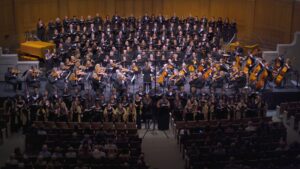
Winston Salem Symphony with local choirs performing Beethoven’s 9th Symphony
WINSTON-SALEM, NC – Symphony No. 9 in D minor, Op. 125 (“Choral”) by Ludwig van Beethoven (Germany, 1770-1827) is truly one of the turning points in music history. It is the first “symphony” (meaning instruments only) to incorporate choir and soloists, its length is likewise unusual (over an hour long), and its call for universal brotherhood is unheralded. That it was the composer’s last symphony also loomed large over those 19th-century composers who came later. Because of the work’s overwhelming impact, and because it was Beethoven’s last, some thought writing a ninth would be their last as well. And indeed, it was for Gustav Mahler.
Saturday night’s performance under the direction of Winston-Salem Symphony music director Michelle Merrill in the cavernous Wait Chapel on the campus of Wake Forest University brought together a large orchestra as well as a 150-voice choir featuring the combined forces of the Winston-Salem Symphony Chorus, the Winston-Salem State University Singing Rams, and the Wake Forest University Choir, all under the direction of chorus director Chris Gilliam. The work was first performed in 1824, so this performance was a 200th anniversary of the revered masterpiece.
The opening movement moves between darkness and despair (D minor) and hope and light (D Major), and Maestra Merrill chose a great tempo to highlight the contrast between the dramatic and the gentle.
The second movement is all about speed and relentless movement, with timpani (wonderfully executed by Peter Zlotnick) adding to the ruckus. The middle section was taken at a break-neck speed, and bassoonist Saxton Rose negotiated his accompaniment to the oboes without a hitch.
The slow third hymn-like movement “dwells in the realm of pure melody and dance,” as accurately described by David B. Levy in his excellent program notes. Hints of the “Joy” theme can be discerned here, a foreshadowing of the finale.
The famous last movement starts with what Wagner called “the fanfare of horror” followed by a unison low string “recitative.” The fanfare returns with accompanying recitative, but this time, the opening of each of the three movements is presented. Finally, the “Joy” theme appears and is treated to a series of variations before the fanfare is heard once more, to which baritone Jason McKinney sang sturdily and dramatically “Oh friends, not these sounds. ”
What followed was a potpourri of styles (including a “Turkish” march), duets between bass and clarion-voiced tenor Scott Ramsay, vocal quartets featuring bass and tenor as well as soaring soprano Kathryn Mueller, and richly hued mezzo soprano Laurel Semerdjian. And, of course, the huge choir, which was too large for the stage, so it spilled into the first three aisles of the floor. Chorus preparation by Chris Gilliam and Maestra D’Walla Simmons-Burke was superb. From full-out fortissimos to hushed pianissimos, choir and orchestra ended this marathon vocal/instrumental masterpiece in fine style.
Opening the concert was Beethoven’s Leonore Overture No. 3 (one of the four preludes the composer wrote for his opera Fidelio), which provided a hint of the suspenseful and energetic evening that was to ensue. The work is a wonderful piece of music independent of the opera, full of drama as well as light-hearted moments that the W-SS frolicked in.
The four soloists from the Ninth sang Beethoven’s “Mir ist so wunderbar” from Fidelio (1806), his only opera. In the scene from which the quartet is sung, Leonore (dressed as a man – “he” is going to rescue the hero, Florestan) is loved by the jailor’s daughter, who in turn is loved by the assistant jailor, and the jailor comments about how well suited the two women would be. Each singer expresses their feelings to the same music with different instrumentation, a great creative stroke by the composer. The four contrasting moods portrayed gave each of the soloists a chance to shine.
Closing out the first half was Fate Now Conquers (2020) by Carlos Simon (U.S., b. 1986), which, the composer states, uses “the beautifully fluid harmonic structure of the second movement of Beethoven’s Seventh Symphony.” I find myself in complete agreement with notes writer Levy, who states that one would be “hard pressed to actually hear how.” That being said, the short five-minute work depicts a dramatic struggle, perhaps representing the power of fate.
Wait Chapel is both a wonderful and problematic venue for orchestral music. While the sound is rich and full, the main themes in the strings were sometimes overshadowed by brass or winds, and occasionally the instrumental ensemble was not always together. Furthermore, the audience applauded between each movement, which reduced the organic structure of the Ninth Symphony.
One left the concert feeling rather amazed at the amount of work that went into preparing this mammoth undertaking. The 9th Symphony is a long, problematic work, and sometimes a challenge for the listener to follow. Nonetheless, the overall optimism expressed is one of the reasons the work is so beloved, and the commitment of instrumentalists and singers was inspiring.










